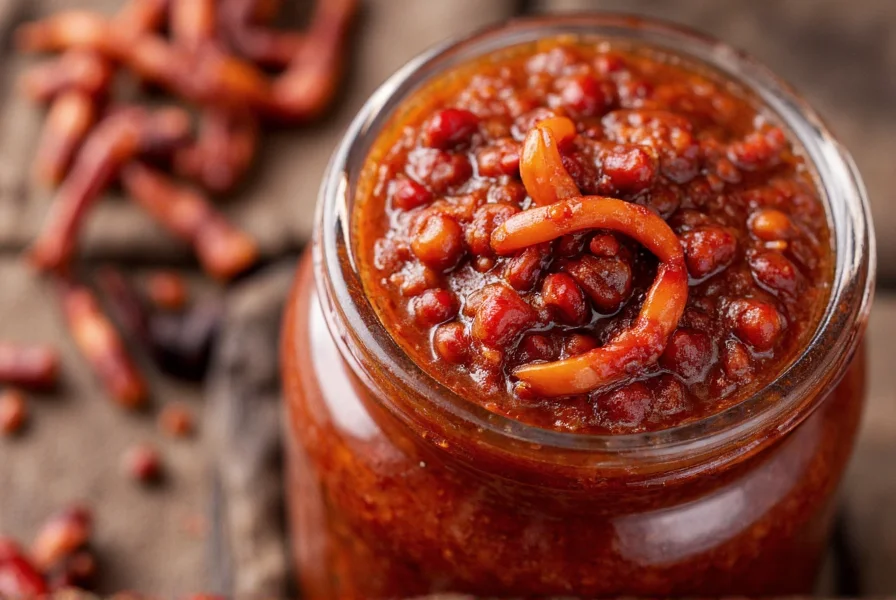Understanding this fundamental ingredient transforms your cooking capabilities, whether you're preparing traditional mapo tofu or experimenting with fusion recipes. Properly used, chili bean sauce creates restaurant-quality depth that elevates everyday meals without overwhelming other flavors.
What Exactly Is Chili Bean Sauce?
Chili bean sauce, known as doubanjiang in Mandarin, represents one of Chinese cuisine's foundational fermented ingredients. Unlike simple hot sauces, authentic chili bean sauce combines fermented broad beans (fava beans), soybeans, chili peppers, salt, and sometimes rice or wheat. The fermentation process—often lasting six months to several years—creates complex enzymatic reactions that develop rich umami compounds.
Two primary varieties exist in authentic Chinese cooking:
| Type | Color | Heat Level | Primary Use |
|---|---|---|---|
| Sichuan Doubanjiang | Deep red-brown | Medium-high | Stir-fries, braises, mapo tofu |
| Yellow Bean Sauce | Lighter brown | Mild | Marinades, dipping sauces |

How Chili Bean Sauce Differs From Similar Condiments
Many home cooks confuse chili bean sauce with other Asian condiments, but key differences affect recipe outcomes:
- Chili bean sauce vs gochujang: Korean gochujang contains sweeteners like sugar or rice syrup and has a sweeter, thicker profile, while Chinese chili bean sauce focuses on savory bean fermentation
- Chili bean sauce vs sambal oelek: Indonesian sambal is pure chili paste without fermented beans, delivering straightforward heat without umami depth
- Chili bean sauce vs fermented black beans: Douchi (fermented black beans) are salted black soybeans without chili content, offering different flavor dimensions
Understanding these distinctions prevents recipe failures when substituting ingredients. The unique combination of fermented beans and chilies in authentic chili bean sauce creates irreplaceable flavor complexity in traditional dishes.
Mastering Culinary Applications
Professional chefs treat chili bean sauce as a flavor foundation rather than just a heat source. For optimal results:
- Bloom in oil first: Always stir-fry chili bean sauce in hot oil for 1-2 minutes before adding other ingredients. This "blooming" process unlocks aromatic compounds and integrates flavors
- Balance with sweetness: Counterbalance the saltiness with small amounts of sugar, honey, or Chinese cooking wine
- Layer with aromatics: Combine with ginger, garlic, and scallions for complete flavor development
- Adjust quantity carefully: Start with 1-2 teaspoons per serving and adjust—its potency varies significantly between brands
Traditional applications include:
- Mapo tofu (the essential flavor base)
- Sichuan dry-fried green beans
- Red-braised pork belly
- Spicy wonton dipping sauce
- Modern fusion applications like chili bean aioli

Storage and Shelf Life Considerations
Proper storage maintains chili bean sauce's complex flavor profile. Unopened jars remain shelf-stable for 18-24 months. After opening:
- Refrigerate immediately in an airtight container
- Always use clean utensils to prevent contamination
- Press plastic wrap directly onto the sauce surface before sealing to minimize oxidation
- Discard if mold appears or if significant color/lightening occurs
High-quality fermented chili bean sauce actually improves in flavor for 3-6 months after opening when properly stored, as fermentation continues slowly in the refrigerator.
Substitution Guidance When Unavailable
While no substitute perfectly replicates authentic chili bean sauce, these alternatives work in specific contexts:
- For mild applications: Combine miso paste with a small amount of cayenne pepper (1:1 ratio)
- For medium heat dishes: Mix gochujang with fermented black beans (2:1 ratio)
- Emergency substitute: Blend tomato paste, soy sauce, and red pepper flakes (use sparingly)
Remember that substitutions alter the dish's fundamental character. Authentic recipes featuring chili bean sauce as the primary flavor component won't achieve the same results with alternatives. When possible, seek authentic brands at Asian grocery stores rather than relying on substitutions.











 浙公网安备
33010002000092号
浙公网安备
33010002000092号 浙B2-20120091-4
浙B2-20120091-4